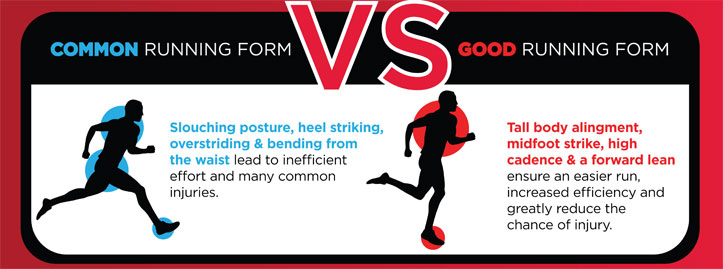If you’re focused on really getting into shape and looking great, then you probably know running to be one of the most effective cardio workouts to get fit and lean.
The problem is… if you’re like most people, you haven’t been able to get comfortable enough in your run to build the physical conditioning that you want.
Has your discomfort also been compounded with some chronic soreness and aches during and after your run?
 If any of this rings true for you then there’s a good chance I can show you how to make some simple adjustments to your running form that will drastically reduce any chronic discomfort, aches and pains… and get you back to your peak performance running levels so you can start experiencing that “Runner’s High” again.
If any of this rings true for you then there’s a good chance I can show you how to make some simple adjustments to your running form that will drastically reduce any chronic discomfort, aches and pains… and get you back to your peak performance running levels so you can start experiencing that “Runner’s High” again.
As you might already know, running is one of the most efficient ways of transforming your body to get that lean and toned look. In addition, scientific studies have proven that endorphins are released in the brain at certain exercise intensities and durations, which can both give you that sense of elation, as well as suppress pain in a similar way to what the drug morphine can do.
The name “Runner’s High” was coined to describe this highly addictive mental and physical state that comes from a high level of intensity and duration reached while you’re running. The fascinating part is that once people experience Runner’s High, it can become a key motivator that reinforces the love of running.
While Runner’s High is great, if you are experiencing chronic discomfort or pains in your body that flare up as a result of running, then there’s a good chance that you won’t be able to sustain the intensity, duration, and/or consistency it takes to reach the Runner’s High and take fitness and physique to the next level.
As I frequently run along the path along the beach in Santa Monica, I notice many other runners with improper technique, and wonder how their bodies are feeling as they run. Some look like they are running in constant discomfort, while others seem to be keeping a slow enough pace just to avoid significant discomfort so they can reach a further distance. I am amazed at how this group of runners perseveres, and still finds reward in the accomplishment of their trek despite the obvious discomfort.
I wonder if any of this might this describe you?
If so, wouldn’t it be great if you could still achieve that self-satisfaction- but without the aches and pains?
The truth is that some surprisingly some minor adjustments in your running form can make that a reality.
What Is Proper Running Form?
As an expert in Kinesiology and how the body was intended to move, often times when I examine a new client’s running technique I find that their overall “movement strategy” needs adjusting. The basic concept behind good kinetic technique in running (the movement strategies associated with running) is to use the body in the most efficient manner as you harness the forces created with each running stride. In short, the body’s goal is to turn each stride into elastic energy to generate the momentum that propels us forward. And in that same process the body is also working to dissipate forces created by movement in order to minimize residual stress that could negatively impact the body and cause unnecessary wear and tear.
 Proper running form is the single most important thing that dictates how efficiently our body is able to reach the intensity and duration needed to get results from running and improve your fitness.
Proper running form is the single most important thing that dictates how efficiently our body is able to reach the intensity and duration needed to get results from running and improve your fitness.
For many of my clients, we discover that their bad habits in running were a result of a lack of awareness of their own bodies “movement strategies”, a lack of knowledge of proper technique, or from compensation from restricted ranges of motion or injury. Most of the time these habits and conditions have been formed over years and are key contributors to the physical ailments or pain experienced with running.
In order to correction these bad habits and improve your running experience there are a few key areas you need to know to focus on:
- Consistent stretching- often times pain and poor movement habits are a result of insufficient flexibility Identification and usage of proper running form- you need to stop your old habits and discover how to move and run properly in your body
- Re-Training – you need to spend time practicing your movement using a higher level of awareness in order to allow your body to “re-learn” a new proper way of moving.
- The truth is that if you continue to ignore proper technique, you end up working harder and expending more energy than you need to. Poor form also creates unnecessary stress in certain parts of our body, which may eventually cause breakdown. That undue stress may be resulting from a high concentration of external compressive force from ground reaction and gravity. It may also be from overuse due to compensations. Eventually, all of this together can make our muscles become dysfunctional because they are working in ways in which they are not designed.
Conversely, proper running form allows our body to move efficiently in the way it was intended, and be uninhibited in reaching its fitness level potential.
The best and fastest course of action in improving form is to consult an expert about how to be more efficient in your run. It takes a trained objective eye to assess and make corrections. I’ve helped many people with this sort of thing, and they were able to realize immediate benefit to their running.
Here are some simple steps to help with your running form if you’re not able to consult an expert soon:
- Lightly stretch beforehand
- Maintain good posture, and be as tall as your full height while you run, instead of appearing to be sitting in a bucket.
- Relax your shoulders down and keep them wide spread.
- Keep your eyes on the horizon, and not down at the ground.
- Keep elbows tight to your side while you simultaneously drive one elbow back, and the opposite unclenched fist forward at a rate and range of motion in accordance to your stride length (Do not let hands and arms cross in front of the body)
- Concentrate more on your hips and mid-section being your power center, instead of trying to power all from the legs. It should look as though you are leading through your hips, instead of running with a “poopy diaper”.
- Land on your mid-foot directly under your body and roll through the front of your toes. If your lower leg extends out in front of your body, your stride length is too long.
- Make ground contact quiet, instead of loud and hard. Then roll forward of the forefoot straight and spring off the ground.
- Lessen the up and down and/or side-to-side movement of your head and torso. (No bobbing, bouncing, or swaying)
- Thoroughly stretch afterwards
In order to make these corrections stick, it means you get to allow for a short-term sacrifice of your usual intensity and distance, to ultimately have even greater results and longevity in the future. Initially you get to consistently practice and closely observe these techniques on shorter runs only. Otherwise old habits may tend to creep back when we fatigue and we lose focus, which will diminish results. Remember that perfect practice makes perfect. Over time you can build back to longer and intense runs to your liking.
The benefits of improving your form goes well beyond just running, as it applies to all exercise. Form & Technique, posture, body alignment, and awareness…these can seem like a lot, but to a trained professional they can put it all together at once and make it simple.
If you are recognizing that you have either chronic pain, improper running form or problems with your overall movement strategy that are keeping you from doing the activities you want and achieving the level of fitness you’re looking for… then I’d like to help. Feel free to reach out and let me know your personal challenges.
In the meantime, I suggest you start to take notice of your running form, and build from the guidelines stated above by focusing only on three adjustments per run at a time. This way you won’t become overwhelmed, and you can progress at your own pace.
While on your way to mastering your running technique, you should find that you will have improved performance and much more enjoyable time. Try it on!
*Before engaging in any high intensity cardiovascular exercise, make sure that you are good health, and get cleared by your doctor to participate.

